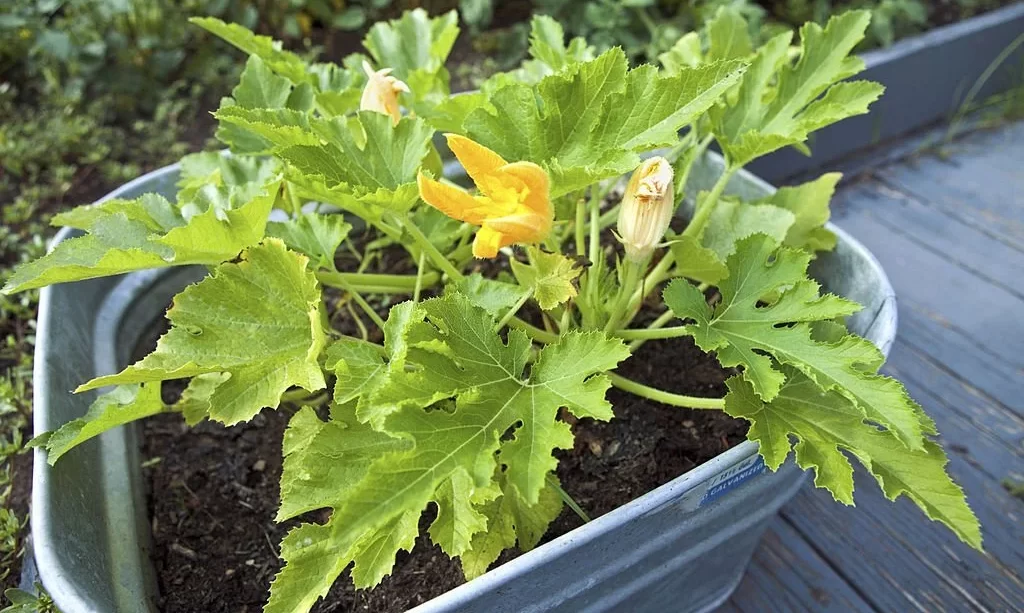Container gardening has revolutionized how people cultivate plants, especially in limited spaces. Growing vegetables in pots and containers offers convenience, flexibility, and the ability to enjoy homegrown produce even without a traditional garden. Among the many vegetables suitable for container gardening, squash stands out as a versatile and rewarding choice. In this article, we will explore the world of growing squash in a pot, from selecting the right container to caring for your squash plants. Whether you have a small patio, balcony, or just want to make the most of your available space, this guide will help you embark on a fruitful journey of compact gardening with squash.
- High quality material: Made of breathable and durable non-woven fabric, BPA-free. Fabric bags ensure good ventilation to prevent excessive moisture, provide more oxygen and improve plant growth by air pruning roots
- Easy to move: Wide and reinforced handles ensure it easy and safe to transport the bags filled with soil and plants. Grow bags are perfect to use at patios, gardens, balconies, sunrooms and any indoor/outdoor space
- Great drainage: Nonwoven fabric provides excellent drainage through the soil and prevents rotating roots from accumulating. Allow plant roots for healthier breath and more vigorous growth. Keeps plant warmer in winter and cooler in the summer
- Easy to store and reuse: Washable for reuse and easy to clean. At the end of the growing season, you may empty the bags, simply clean them and store dry. Easily fold up and won’t take up much space when storing
- Enjoy gardening easily: Grow more in less space but multiple varieties in grow bags. 5-pack 5 gallon fabric grow bags. Pot dimension: Diameter 12 inches, height 10 inches
Why Choose Squash for Container Gardening
While container gardening can accommodate various vegetables, squash has several attributes that make it an excellent choice for this space-efficient method:
- Bush Varieties: Many squash varieties, particularly bush or compact ones, are well-suited for container gardening. These types have a more compact growth habit, making them ideal for limited spaces.
- Abundant Harvests: Squash plants are known for their prolific production. With the right care, a single squash plant in a pot can yield an impressive quantity of delicious squash.
- Culinary Versatility: Squash is a versatile vegetable that can be used in a wide range of dishes, from sautés and salads to casseroles and soups. Its culinary versatility ensures that you’ll find numerous ways to enjoy your homegrown squash.
- THE FRESHEST SEEDS – 2025 SEASON: Elevate your gardening game with our freshest seeds, ensuring high germination rates. Make gardening a joy, where success sprouts effortlessly and blooms into a kaleidoscope of colors.
- PREMIUM GIFTABLE PACKAGING: Unwrap gardening delight with our premium seed packaging. Tailored for optimal storage, complete with planting instructions and a reusable zipper – a thoughtful gift for any nature-loving enthusiast.
- GUARANTEED TO GROW: Plant with confidence! We stand by our seeds. If they don’t germinate, we’ll refund you within 30 days, no questions asked. Sweet Yards guarantees a worry-free and flourishing garden.
Selecting the Right Container
Choosing the right container is a crucial first step in successfully growing squash in a pot. Here are the key considerations:
- Size and Depth: Opt for a container that provides enough room for the squash plant’s roots to grow. A pot with a minimum depth of 18 inches (45 cm) is recommended to accommodate the root system.
- Material: Select containers made of materials like plastic, ceramic, or lightweight wood. Ensure that the chosen material is sturdy and durable to support the growing squash plant.
- Drainage: Proper drainage is essential to prevent waterlogged soil, which can harm the squash plant. Ensure that the container has drainage holes at the bottom.
- Container Shape: Squash plants have sprawling growth habits, so a wide, round or rectangular container is preferable to provide ample space for the plant to spread.
- Portability: Consider the weight of the container, especially if you plan to move it around. Large plastic pots or grow bags are lightweight and easy to manage.
By carefully selecting the right container, you provide a solid foundation for your squash plants to thrive in a confined space. With your container in place, you can proceed to prepare the soil and begin the exciting journey of growing squash in a pot.
Soil and Planting
Preparing the right soil mix and planting your squash properly are essential for success in container gardening:
- Soil Mix: Create a well-draining and nutrient-rich soil mix by combining potting soil with organic compost. Aim for a loose, friable texture that allows water to pass through easily while retaining moisture and nutrients.
- Planting Depth: Plant squash seeds or seedlings at the recommended depth, usually around 1 to 1.5 inches (2.5 to 3.8 cm). Ensure that the soil surface is level and firm to support the young plants.
- Spacing: Depending on the squash variety, provide adequate spacing between plants to avoid overcrowding. Bush varieties may need around 12 inches (30 cm) of space between plants.
- ALL-IN-ONE POTTING SOIL SOLUTION: FoxFarm ocean forest potting soil is a blend designed to give your plants everything they need to thrive. Ideal for container plants, this planting soil provides optimal nutrient and soil aeration
- MOISTURE-LOCKING NUTRIENT BLEND: This organic potting soil for plant is packed with aged forest products, sphagnum peat moss, earthworm castings, bat guano, and fish emulsion, each ingredient enhances moisture retention and nutrient uptake
- TOP-NOTCH SOIL FOR EVERY PLANT: From roses and shrubs to seedlings and trees, this garden soil supports vigorous growth and branching. This outdoor & indoor plant soil’s pH-adjusted blend promotes healthy, lush foliage for all plant varieties
- YOUR GO-TO SOIL FOR ALL MEDIUMS: Our potting soil mix is perfect for container gardens, houseplants, and outdoor setups. Ocean plant versatile blend provides a balanced environment for robust growth, ensuring your plants thrive in any setting
- CONVENIENT SOIL READY TO USE: This houseplant potting soil is ready to use out of the bag, no additional ingredients are needed. Use for planting or top-dressing, with the optional pairing of FoxFarm liquid fertilizers for enhanced growth all season
Sunlight and Watering
Proper exposure to sunlight and consistent watering are critical for the health and productivity of your container-grown squash:
- Sunlight: Squash plants thrive in full sun, which typically means they need at least 6 to 8 hours of direct sunlight each day. Place your container in a sunny spot or use a gardening light if your space lacks adequate sunlight.
- Watering: Maintain consistent moisture levels in the soil, as squash plants are heavy drinkers. Water the container thoroughly when the top inch (2.5 cm) of soil feels dry to the touch. Be careful not to overwater, as this can lead to root rot.
- Mulching: Applying mulch to the soil surface can help retain moisture, regulate soil temperature, and reduce weed growth. Organic mulch, such as straw or shredded leaves, is a great option.
Care and Maintenance
Taking care of your container-grown squash involves several essential practices:
- Pruning: Regularly prune your squash plants to remove excess foliage and encourage air circulation. Pruning also helps prevent overcrowding, making it easier for the remaining fruits to develop.
- Support: Some squash varieties may benefit from a trellis or support structure to keep the vines off the ground. This not only saves space but also prevents diseases caused by soil contact.
- Pollination: Squash plants require pollinators, like bees, for fruit development. If pollinators are scarce, consider hand-pollinating by transferring pollen between male and female squash flowers using a soft brush or cotton swab.
- Pest and Disease Monitoring: Keep an eye out for common squash pests like aphids and squash bugs, as well as diseases like powdery mildew. Early detection and appropriate treatment or prevention measures are essential.
By following these care and maintenance practices, you can ensure that your container-grown squash plants remain healthy and productive throughout the growing season. With proper attention and a little effort, you’ll soon be enjoying the fruits of your compact gardening efforts right on your balcony or patio.
Harvesting Squash from Containers
Harvesting squash from your containers is a rewarding experience. Here’s how to do it properly:
- Timing: Different squash varieties have varying maturity times, so consult the seed packet or plant label for guidance. Generally, squash is ready for harvest when it reaches the desired size and has a glossy, vibrant color.
- Harvesting Method: Gently cut or twist the squash from the vine, using a sharp knife or pruning shears. Be careful not to damage the plant or nearby fruits during the process.
- Frequency: Harvest squash regularly to encourage continuous production. The more you pick, the more your plant is likely to produce.
- Storage: Store freshly harvested squash in a cool, dry place or in the refrigerator to maintain freshness. Use them promptly to enjoy their peak flavor and texture.
Tips for Success and Troubleshooting
To ensure a successful container gardening experience with squash, consider these tips and be prepared to address common issues:
- Fertilization: Supplement your squash plants with a balanced, slow-release fertilizer to provide essential nutrients throughout the growing season.
- Pest Control: Keep a watchful eye for pests like aphids, squash bugs, and cucumber beetles. Use natural or organic pest control methods to protect your plants.
- Powdery Mildew: If you notice the development of powdery mildew on the leaves, treat it promptly with fungicides or follow preventive measures, such as proper spacing and good air circulation.
- Supportive Structures: Install support structures, like trellises or stakes, early in the growing season to avoid damaging mature plants.
- Companion Planting: Explore companion planting techniques to deter pests and enhance the health of your squash plants. For example, planting marigolds or nasturtiums nearby can help deter certain pests.
- STIMULATE & ACCELERATE: An acidic foliar fertilizer that feed through roots and leaves which contains a blend of plant growth stimulants and other nutrients designed to accelerate plant growth and improve yields
- MICRO-NUTRIENTS: Contains micro-nutrients and vitamins plants need
- HIGH CONCENTRATE: 1-2 oz per gallon of water; makes up to 32 gallons of fertilizer
- GUARANTEED ANALYSIS: 11% Nitrogen | 8% Phosphorus | 5% Potassium with .02% Boron .1% Iron .05% Manganese .05% Zinc
- MEASURE & POUR: Comes in an easy measure and pour bottle that allows the end-user to measure and pour a specific dosage by simply squeezing the bottle. See images for directions.
Conclusion
In conclusion, growing squash in containers is a practical and rewarding way to enjoy the fresh, flavorful produce of your labor, even in limited gardening spaces. By selecting the right container, preparing suitable soil, and providing adequate sunlight and water, you can nurture thriving squash plants that yield a bountiful harvest.
Harvesting your homegrown squash is a satisfying experience, and the culinary possibilities are endless. From roasted delicata squash to creamy butternut squash soup, your container-grown squash can become the star ingredient of your favorite dishes.
While challenges like pests and diseases may arise, a proactive approach to care and maintenance can help you address these issues effectively. By following the tips outlined in this guide and troubleshooting any potential problems, you’ll be well on your way to successfully growing squash in containers.
So, whether you’re a gardening enthusiast with limited space or simply want to explore the joys of homegrown squash, don’t hesitate to embark on this journey of compact gardening. With dedication and a little green-thumb magic, you’ll be enjoying the delicious fruits of your container-grown squash in no time.







